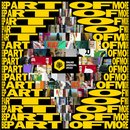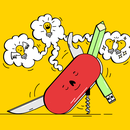Become an Illustrator
Tips on how to land work as an illustrator from professional illustrators

Illustrators are artists and visual storytellers. You’ve heard a picture is worth a thousand words, and this holds true for illustration. Drawings bring ideas to life, help communicate meaning and draw an audience into a piece of creative work — be it a children’s book, a magazine cover, a design for a dress or a poster for a charity. Editorial publications, advertising agencies, NGOs and brands all commission illustration.
If you’re someone who finds joy in drawing and communicating through visual means, you may be considering making it your career. And as it is with any artistic pursuit, making this into your living may seem daunting in the beginning. We spoke to four professional illustrators and one illustration agent to get their tips on what to do when you’re just starting out. Here’s what they had to say.
Don’t be in a rush to find a particular style
Most famous illustrators have an easily recognisable personal style (we can spot a Quentin Blake book cover from a mile away), and many professional illustrators have a particular niche (they could primarily be fashion illustrators for example). It may be tempting to rush into finding a style or niche, but our experts say that things are more likely to fall into place when you take your time to experiment and find your feet as an artist.
Jasmin Sehra, now a freelance illustrator who has worked with brands including Coca-Cola, Estée Lauder and Nike, worked on self-initiated projects, attended workshops, and learned at home via tutorials and experimentation, before eventually growing her creative profile on social media, which allowed her to work full time in design. Sehra says, “There is no rush in finding a particular niche or style. Experiment with everything and it’ll all fall into place when it’s meant to. Things take time, so be patient and keep consistent.” Likewise, freelance illustrator and chronic illness activist Ananya Rao-Middleton, who has worked with the likes of Instagram, Refinery29, UK Parliament and Schuh, says, “It can feel stressful to think that you can only be an illustrator once you’ve found your style. The truth is, your style will always evolve the more you learn and the more you illustrate. Feeling comfortable with that fact is something that will empower you to be more playful and at ease with your work and it looks.”
Put your work out there
As with most opportunities in the creative industry, it’s hard to find a gig unless people see your work. Lauren Morsely, an award-winning illustrator who recently worked on a D&AD for an online content series, “Don't be afraid to share your art. Be bold and proud of it even if you feel it isn't your best work or it isn't finished. It is all part of the process and the only way you can develop your voice as a creative.”
Putting your work out there may seem scary, but it definitely pays off. Rao-Middleton, who started painting after an accident left her unable to work for six months, says her illustration career is a direct result of creating artwork and showcasing it. She says, “I decided to continue to create artwork, made a website for my portfolio, began to follow like-minded illustrators and eventually built up a base of clients, which has led me to where I am today.”
This is such popular advice, Kat Irannejad, co-founder and executive illustration agent at Snyder New York mentions it too, saying, “It won't work if you aren't willing to be proactive, or if you're too shy, or unwilling to put yourself out there. And by 'out there' I mean among your peers or among possible clients. You have to want to pursue it, and genuinely understand success won't magically come to you while you just sit and remain passive.”
Award-winning freelance illustrator Erin Aniker who has worked with clients including Nike, Apple and HuffPost also has similar advice saying, “Be vulnerable and put your work out there.... Contact people you’d like to work with.” If you’re ready to take the leap, sites like Sqaurespace, Behance and Wordpress offer an easy opportunity to get your work online. Make that portfolio, and show it to people you admire.
Don’t stress about professional training
Illustration is an art, and artists can be both born and made — trained and self-taught. In this sense, don’t worry too much about not having professional training if you don’t have an art degree but think being an illustrator is your calling. Rao-Middleton says, “It does not matter whether you are professionally trained as an illustrator/artist or not. What matters is the work you produce. When I started illustrating I felt very self conscious that I hadn’t been to art school or had any formal training, but when I reflected on the work I’d been able to create — none of that really matters.”
Similarly, Aniker says, “I studied an art foundation and then a BA undergraduate degree in Illustration at university but I don't think you need any degree or formal qualifications to work as an illustrator.” She does say her degree helped her get gallery and museum internships and later day jobs in arts marketing which were useful to her. But not having a degree in illustration is not a deal breaker.
Don’t be afraid of failure
When you’re a professional artist, rejection is the name of the game. Even some of the greatest artists of all time, including Van Gogh and Monet, have been rejected and criticized. During the course of your career you’ll probably be rejected a multitude of times, and that’s okay. Sehra says, “Don’t fear failure. Uncomfortable situations are where growth resides; everything is a learning curve. Enjoy the process and remember nothing is smooth sailing, it's totally normal and okay to have ups and downs.”
Get on board with research and admin work
If you’re just starting out, it’s likely you won’t have an agent. Irannejad mentions that she does a lot of admin and research work for her clients including handling the “nitty gritty behind-the-scenes admin (vendor paperwork, contracts, billing)”, paying attention to industry trends, and keeping her eyes and ears open for potential work opportunities for her roster.
As an artist starting out, you’ll have to learn to do all of the above by yourself. Absorb as much as you can, and stay on top of what’s happening in your industry by bookmarking sites that you find useful and reading them daily or weekly. Aniker agrees, and stresses the importance of researching the industry, as well as creating or joining a creative community.
Remember to have fun
Lastly, remember to have fun with it. Illustration is a form of self expression, and one of the most creative ways to show the world how to feel. Don’t get bogged down by trying to ‘make it’ too soon, and just enjoy the process. Irannejad says, “Whether you're going to be a successful commercial artist or illustration agent, you truly have to enjoy doing it. It's that simple. Show that you love doing what you do — there's nothing more compelling or attractive.”
Similarly Morsley says, “There's plenty of time, whatever people say otherwise, so trust who you are and just explore, create, and have fun with it.”
Get more advice and tips from professional creatives and learn how you can land the creative job of your dreams.
Sign up now



